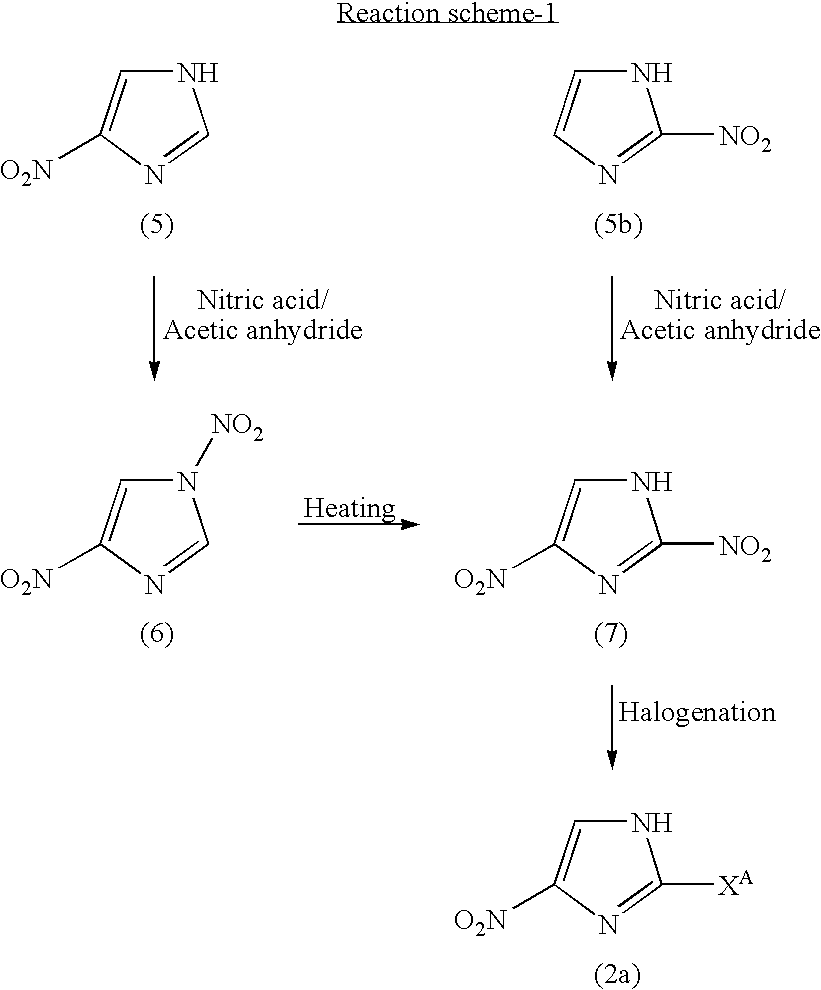1-substituted-4-nitroimidazole compound and process for producing the same
a technology of substituted nitroimidazole and compound, applied in the field of 1 substituted nitroimidazole compound, can solve the problems of high danger of large-scale industrial production of these objective compounds, compounds are in danger of explosion, and are not suitable for industrially applicable preparation methods, etc., to achieve the effect of low danger, high yield and high purity
- Summary
- Abstract
- Description
- Claims
- Application Information
AI Technical Summary
Benefits of technology
Problems solved by technology
Method used
Image
Examples
reference example 1
Preparation of 2,5-dibromo-4-nitroimidazole
[0541] To a suspension of water (100 ml), 4-nitroimidazole (25 g) and sodium hydrogencarbonate (40.87 g), was dropwisely added bromine (26.5 ml) at lower than 10° C., the reaction mixture was stirred at 25 to 30° C. for 1 hour, and at 50 to 60° C. for 4 hours. Then concentrated hydrochloric acid was added to the reaction mixture at lower than 10° C. to adjust pH 1, the crystals separated were collected by filtration, and were washed thoroughly with water. The crystals were dried at 50° C. under a reduced pressure for 24 hours, there was obtained 51.01 g (85.2%) of 2,5-dibromo-4-nitroimidazole of pale yellow powdery product.
reference example 2
Preparation of 2,5-dibromo-1-methoxymethyl-4-nitroimidazole
[0542] Under an ice-cooling condition, sodium hydride (3.56 g) was added to a N,N-dimethylformamide (100 ml) solution of 2,5-dibromo-4-nitroimidazole (20.08 g). 10 minutes later, being added dropwise chloromethylmethyl ether (6.75 ml) thereto at 10 to 15° C., then the reaction mixture was turned back to a room temperature. After being stirred this reaction mixture for 5 hours, under an ice-cooling condition, sodium hydride (0.30 g) and chloromethylmethyl ether (0.56 ml) were added, further stirred at a room temperature for 1 hour. Then the reaction mixture was ice-cooled, water was added and extracted with ethyl acetate. The organic layer was washed with an aqueous solution being saturated with sodium chloride, dried over anhydrous sodium sulfate, then concentrated under a reduced pressure. Thus obtained crude crystals were washed with diisopropyl ether, and dried at 50° C. for 24 hours, there was obtained 2,5-dibromo-1-met...
reference example 3
Preparation of (S)-2-methylglycidyl-4-nitrobenzenesulfonate
[0543] Under cooling at −10° C., to a toluene (830 ml) solution of β-methallyl alcohol (83.0 g), diisopropyl D-(−)-tartrate (16.19 g) and molecular sieves 4A (41.5 g) was added titanium tetraisopropoxide (17.0 ml), after being stirred the reaction mixture at −10° C. for 30 minutes, 80% of cumene hydroperoxide (415 ml) was added dropwise at −10° C. to −2° C. After being stirred the reaction mixture at 0° C. for 22 hours, excess of cumene hydroperoxide was reduced by adding dropwise trimethyl phosphite (141.1 ml) at −20° C. to −5° C. The end point of this reducing reaction was confirmed by use of zinc iodide starch paper.
[0544] Triethylamine (219 ml) was added to the reaction mixture, then toluene (830 ml) solution of 4-nitrobenzenesulfonyl chloride (332 g) was added dropwise at −30° C. to −16° C., and stirred at −10° C. for 1 hour. The reaction suspension was subjected to filtration with celite, and the filtrate was washed ...
PUM
 Login to View More
Login to View More Abstract
Description
Claims
Application Information
 Login to View More
Login to View More - R&D
- Intellectual Property
- Life Sciences
- Materials
- Tech Scout
- Unparalleled Data Quality
- Higher Quality Content
- 60% Fewer Hallucinations
Browse by: Latest US Patents, China's latest patents, Technical Efficacy Thesaurus, Application Domain, Technology Topic, Popular Technical Reports.
© 2025 PatSnap. All rights reserved.Legal|Privacy policy|Modern Slavery Act Transparency Statement|Sitemap|About US| Contact US: help@patsnap.com



